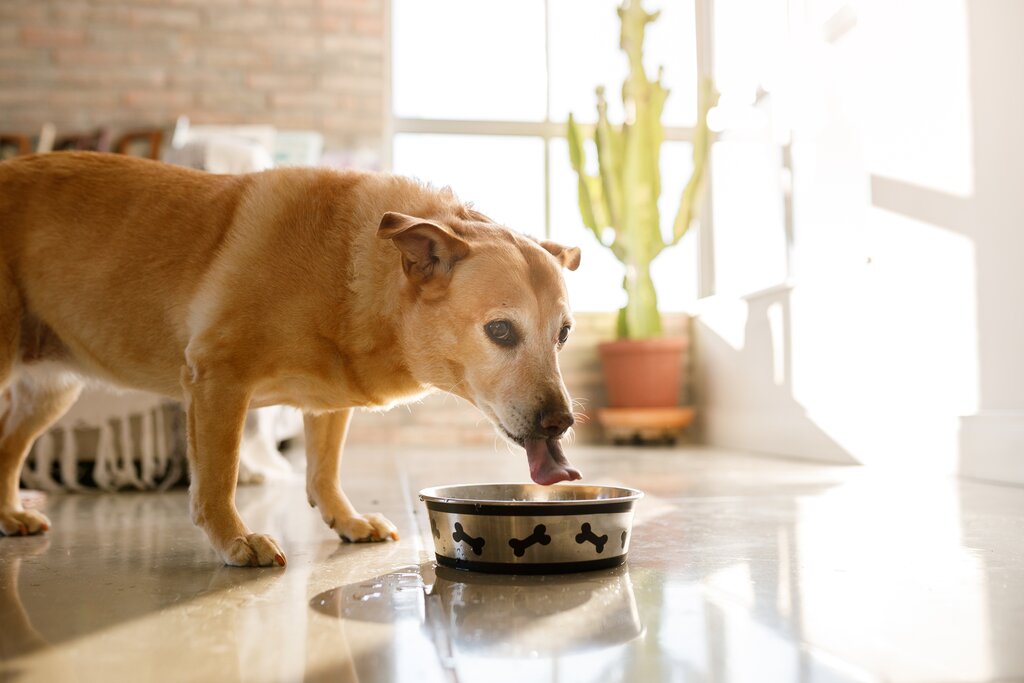Last Updated: 28/03/2025
Cushing's Disease in Dogs
Has your dog been diagnosed with Cushings disease? Find out all about it here.
Author: Dr Carla Paszkowski BVSc (Hons)
Reading Time: 19 minutes - medium read
Does your furry friend have a secret superpower? Perhaps it's the ability to turn a simple walk into an epic adventure. Or maybe it's their knack for finding the perfect spot for a nap. But if your pup's superpowers include excessive drinking, frequent urination, or a potbelly, it might be time to investigate Cushing's Disease.
Whether you're a concerned dog owner or a future pet parent, this guide will help you understand the ins and outs of Cushing's Disease, so you can keep your canine companion happy and healthy.
What is cushings disease in dogs?

Cushing's Disease is the common name for Hyperadrenocorticism - a condition in which the adrenal glands (small glands that sit on top of the kidneys) overproduce cortisol in the dog's body. Excess cortisol causes a number of symptoms and affects almost every body system from the kidneys, to the immune system, the skin, and the liver.
There are three main forms of Cushing's Disease, correlating purely to where the cause of the disease sits anatomically:
- Pituitary Dependent Cushing's. This is the most common form, seen in about 80-90% of dogs with Cushing's. The pituitary gland is a pea sized gland at the base of the brain, and one of its functions is to send signals to the adrenal glands. If the pituitary gland is over active, the otherwise normal adrenal glands will respond to this overstimulation. Usually, a tumour in the pituitary gland causes its hyperactivity - but the tumour itself is oftentimes benign.
- Adrenal Dependent Cushing's. This type of Cushing's is caused by overactive adrenal glands. In most cases, the overactivity is caused by a tumour in an adrenal gland, which causes it to expand and produce excess cortisol. Around 15% of dogs with Cushing's have this type.
- Iatrogenic Cushing's. Iatrogenic typically means 'caused by medication'. This type of Cushing's occurs after a dog has been treated with corticosteroids for a long time.
Did you know? Cortisol is normally used by the body to respond to stress, keep bodyweight in check, fight infections, and maintain blood sugar levels. However, like many hormones, too much or too little Cortisol can cause problems.
Dog breeds that are prone to Cushing's Disease
Small breed dogs are particularly prone to Cushing's Disease, however some large breed dogs are affected more than others too. Certain breeds that are prone to developing Cushing's include:
- The Poodle, especially toy and miniature poodles
- Terriers including Yorkshire, Maltese, and Foxie
- Dachshund
- Boxers
- Staffordshire Terriers
Signs of Cushing's Disease

Cushing's Disease usually occurs in middle aged and senior dogs. Symptoms typically appear gradually over an extended period of time and may include:
- Pot-belly (swollen abdomen) appearance
- Dull or thinning fur, particularly over the torso and abdomen
- Increased thirst and urination
- Increased hunger
- Reduced energy
- Muscle loss
Diagnosis of Cushing's Disease in dogs
Diagnosis of Cushing's Disease requires a veterinary examination and blood tests. Your veterinarian will be able to inspect your dog's appearance, feel their abdomen, listen to their heart, and perform blood and urine tests.
While there is no single test that can diagnose 100% of cases, your vet will likely recommend a combination of the following tests:
- Baseline bloodwork (CBC / biochemistry)
- Urinalysis
- ACTH stimulation test - this involves testing the cortisol levels in the blood before and after giving an injection of adrenocorticotropic hormone (ACTH). In a healthy dog, the cortisol level should rise a little. In a dog with Cushing's, the cortisol will start high and rise even higher.
- Low-Dose Dexamethasone Suppression Test - for this, the dog receives an injection of dexamethasone (a steroid). In a healthy dog, the cortisol level will drop because the steroid suppresses adrenal activity. In a dog with Cushing's, the cortisol levels fail to decline.
- High-Dose Dexamethasone Suppression Test
- Urine cortisol to creatinine ratio
- Abdominal ultrasound (this helps observe any changes in the liver and adrenal glands)
- CT or MRI (this can help identify pituitary tumours)
Treatment of Cushing's Disease in dogs

The good news is that Cushing's in dogs can be easily treated. However, the type of treatment your dog needs depends on the type of Cushing's Disease your dog has.
- If a Pituitary tumour is the cause, treatment can be a little complicated but is usually managed with medication. (Brain surgery to remove a tumour is not the norm in veterinary medicine!) Either trilostane or mitotane might be prescribed for daily administration.
- If an Adrenal tumour is the cause, the best treatment is a surgery to remove the tumour. If the entire tumour can be removed, there is a good chance that the dog will return to normal health.
- If Iatrogenic Cushing's is the cause - ie, caused by administration of steroids - the treatment involves discontinuing the steroids. This often results in a recurrence of the original condition that the steroids were treating, but over time you and your vet may be able to make adjustments in which a balance can be found.
As discussed earlier, a pituitary tumour is the most common cause. A dog with pituitary dependent Cushing's can live a normal active life with medication, which moderates steroid production. It is important not to give too much of your dog's Cushing's medication because if steroid levels drop too low, you may push your dog into Addison's Disease (hypoadrenocorticism).
Ongoing care with regular vet check ups will be necessary to monitor your dog's progress and response to medication.
Home care for a dog with Cushing's
In addition to giving your dog their medication daily, you will need to monitor your dog's drinking and urination. It's important never to restrict your dog's access to water, and your vet may recommend keeping a water diary to note how much your dog is drinking. It's also important to feed your dog an appropriate food and limit treats and table scraps - read more
Further Reading
History
Our experts continually monitor the health and wellness space and we update our articles when new information becomes available.
May 6 2024
Written by Dr Carla Paszkowski BVSc (Hons)Dr Carla Paszkowski BVSc (Hons)
Veterinarian
Dr. Carla graduated from the University of Queensland in 2013 with a Bachelor of Veterinary Science and worked for a number of years in small animal clinics across South East Queensland. While Carla enjoys most facets of clinical veterinary work, she holds a special passion for feline medicine, pocket pets, and nutrition.

